Best office space management software shortlisted
- Archie: Best space management software for affordability, scalability, and ease of use
- OfficeSpace: Strong office space management features on a bigger budget
- Robin: Great for desk & room booking with a costly per-user pricing model
- Envoy: Strong security focus but expensive per-user pricing
- Skedda: High score for ease of use and custom booking workflows
- Kadence: High-quality customer support but limited customization
- Tactic: Straightforward space management software
- Officely: Great for managing office space directly in Slack or Microsoft Teams
Guide to space management software
What is space management software?
Space management software helps you track and optimize your office space usage. It’s a popular tool for hybrid workplaces, coworking spaces, and traditional offices that want to make sure everyone in the organization has easy access to desks, meeting rooms, and other shared spaces whenever they need them.
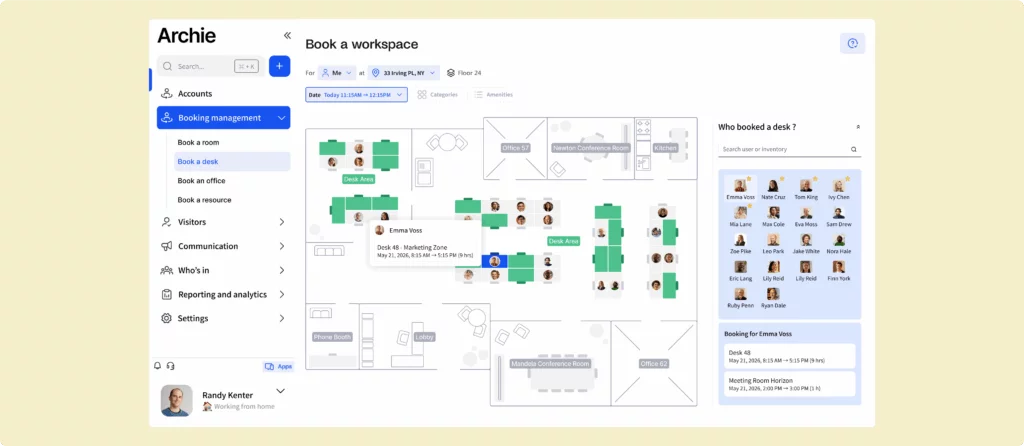
Key features and benefits of office space management software
Office space management software can usually be used through a website or a dedicated mobile app. It lets your employees easily book desks and meeting rooms, plan when to come in, and see where their coworkers are sitting. This helps teams coordinate better and makes office days more productive.
Plus, with built-in reminders and quick check-in options, people are less likely to miss their reservations, which means fewer empty seats and better use of space.
For workplace managers, on the other hand, it offers valuable data and control. You can see which areas are busy or barely used, spot trends, and adjust your layout or downsize to save money. It also makes it easier to welcome guests, track who’s on-site, and keep everything secure.
It’s all possible thanks to the following features:
Multiple booking methods make office reservations easier
A good space management tool lets your employees easily reserve desks, meeting rooms, phone booths, or even parking spots. Bookings can usually be made from different devices like your computer, phone, or even within apps like Slack, Google Calendar, Microsoft Teams, or Outlook.
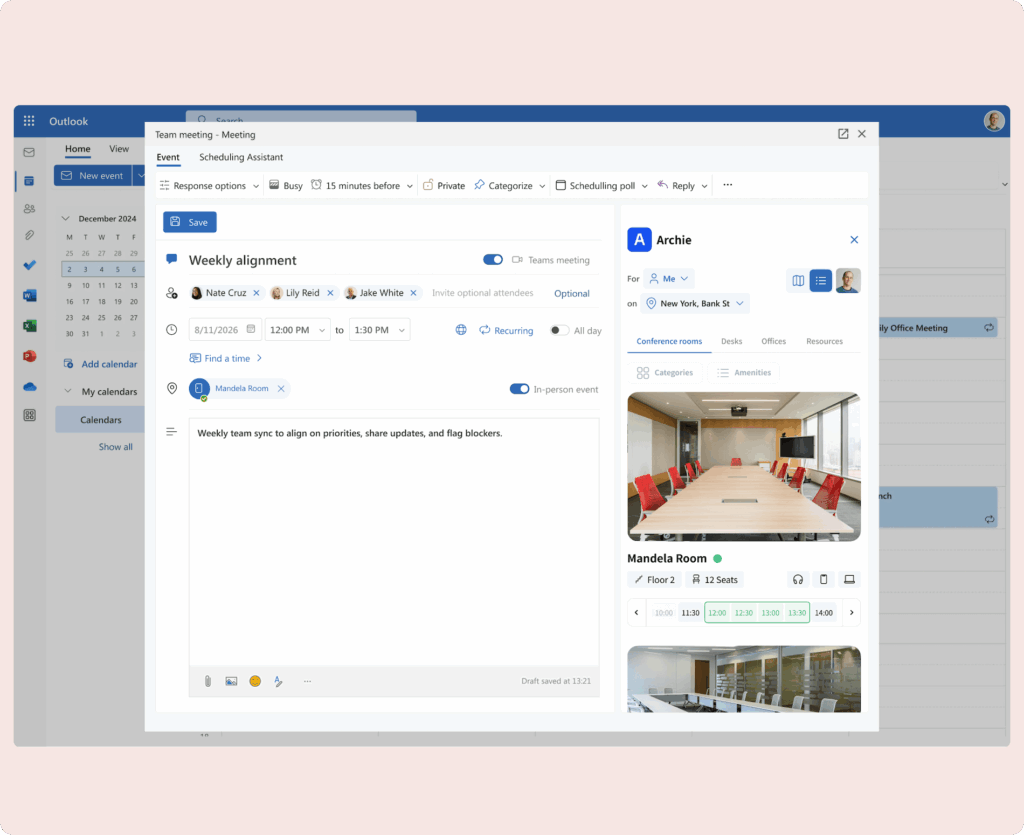
Team scheduling for more productive office days
The space management software helps your employees share their weekly work plans — which days they’ll be working from the office, for example. This makes coordinating easier and encourages more face-to-face time with coworkers. When everyone knows who’ll be in, meetings, projects, and social time become more intentional.
Check-ins and reminders track office attendance
To make sure people actually use what they book, the space management software sends gentle reminders before the reservation. It also lets users check in (with a tap on their phone, a QR code scan, or through Slack). This helps reduce no-shows and gives admins clear records of who was actually onsite.
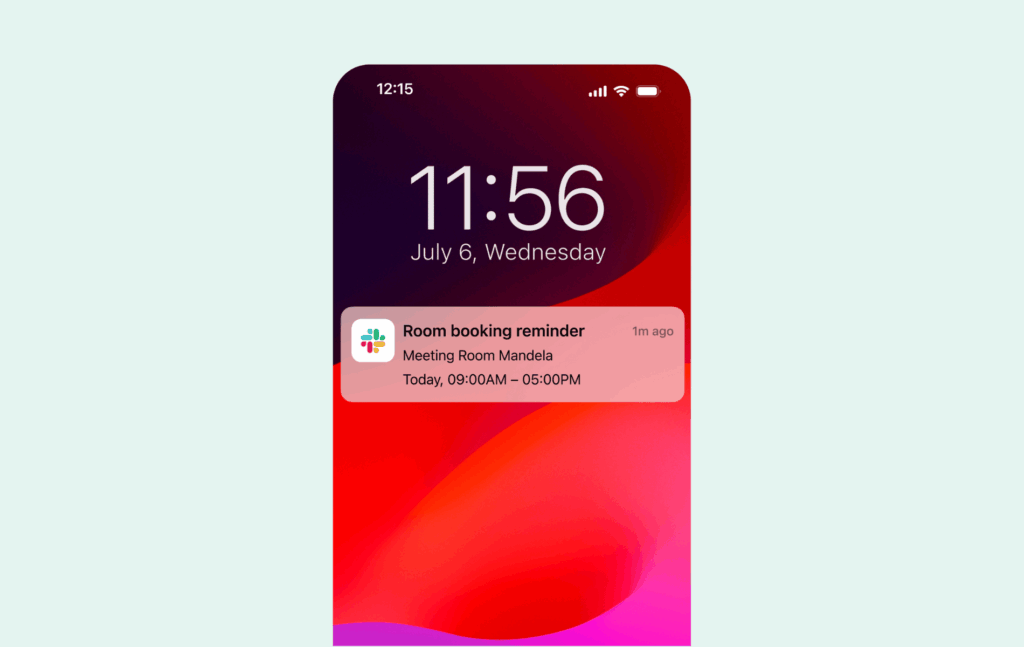
Custom rules that make the office space work for your team
The best space management software lets you assign desks to specific people or teams, restrict who can book certain rooms, and even add buffer times between bookings if needed. You should be able to set up the system to match how your office really works, not the other way around.
Analytics and reporting to understand office usage
Your space management tool should give you useful data, like which rooms are booked the most, what days are busiest, or how often desks are used. This helps you make smart decisions: rearranging layouts, reducing unused space, or even planning for a smaller (or bigger) office if needed.
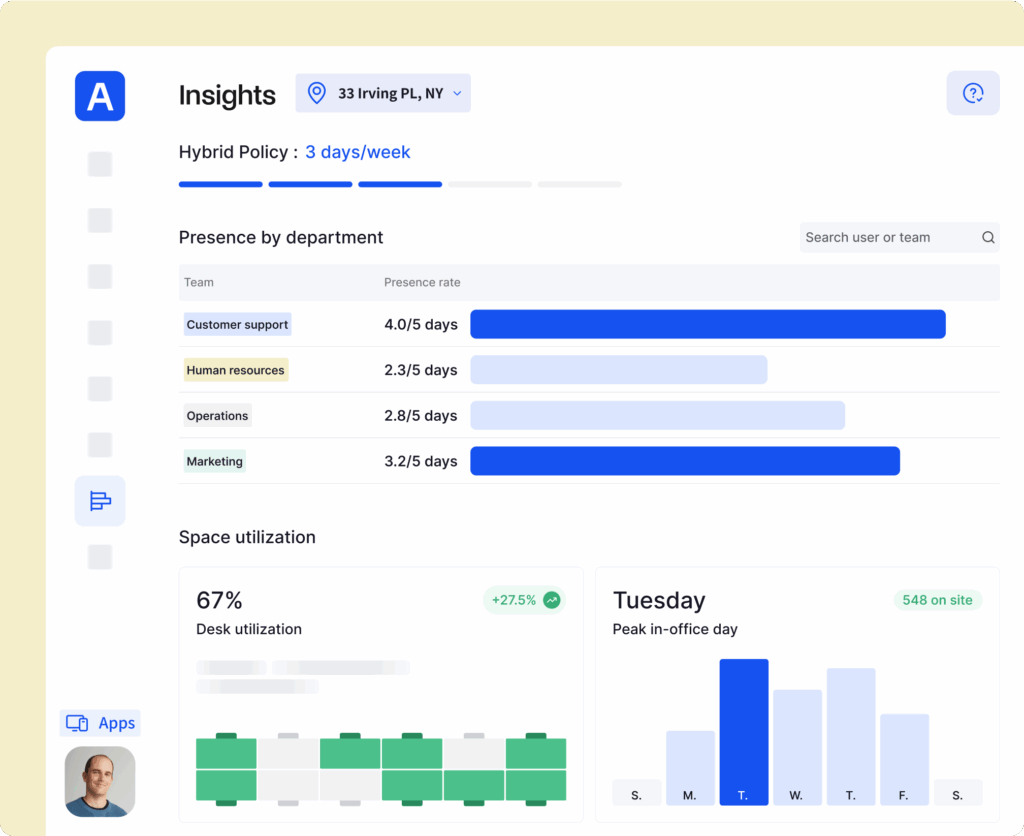
How much does space management software cost?
The cost of space management software depends on how it’s priced — some charge per user, while others charge per resource like desks or meeting rooms.
If your team is growing, a per-user model might get expensive, whereas per-resource pricing can be more budget-friendly for larger companies with more employees than workspaces.
For example:
💰 Archie starts at $159 a month for 25 desks and/or meeting rooms. You can then add extra resources from $2.2 a month.
💰 Officely charges $2.50 per user.
💰 Envoy has a $5 per-user fee.
If you have 100 desks and 200 employees, then you’d pay $324 per month with Archie, around $500 per month with Officely, and up to $1,000 per month with Envoy.
Pay attention to hidden fees, setup costs and missing features in lower-tier plans. Some budget-friendly options may lack essential tools like room booking or visitor management, so looking at the full value rather than just the price is important. Ultimately, a good space management tool should be affordable, scalable, and flexible enough to grow with your company.
Selection criteria for the best office space management software
The best office space management software was researched and rated based on user reviews on G2, Capterra, and product documentation, with an average score calculated across the following categories:
- Ease of use (20%) – How user-friendly the platform is, based on customer reviews and overall interface design.
- Features & functionality (25%) – The range and effectiveness of features (such as desk booking, room reservations, visitor management, and workplace analytics).
- Pricing & value for money (20%) – The cost of the software compared to the features it offers, including whether pricing is per user or per resource.
- Scalability & flexibility (15%) – How well the software adapts to growing teams, office expansions, and hybrid work policies.
- Customer support & reliability (20%) – User feedback on the responsiveness of customer support, software stability, and overall satisfaction.
Best office space management software reviewed
If you want a budget-friendly, flexible, and easy-to-use system, Archie is the best space management software on the market. Here’s why:
#1 Archie
🏆 Rating: 9/10
Archie is the best space management software — it lets employees book desks, reserve meeting rooms, check in visitors, and track office usage, all in one place. Unlike many other office management tools, Archie charges per resource (like desks or meeting rooms) instead of per user, which makes it a better choice for companies with flexible work setups and more employees than office resources.
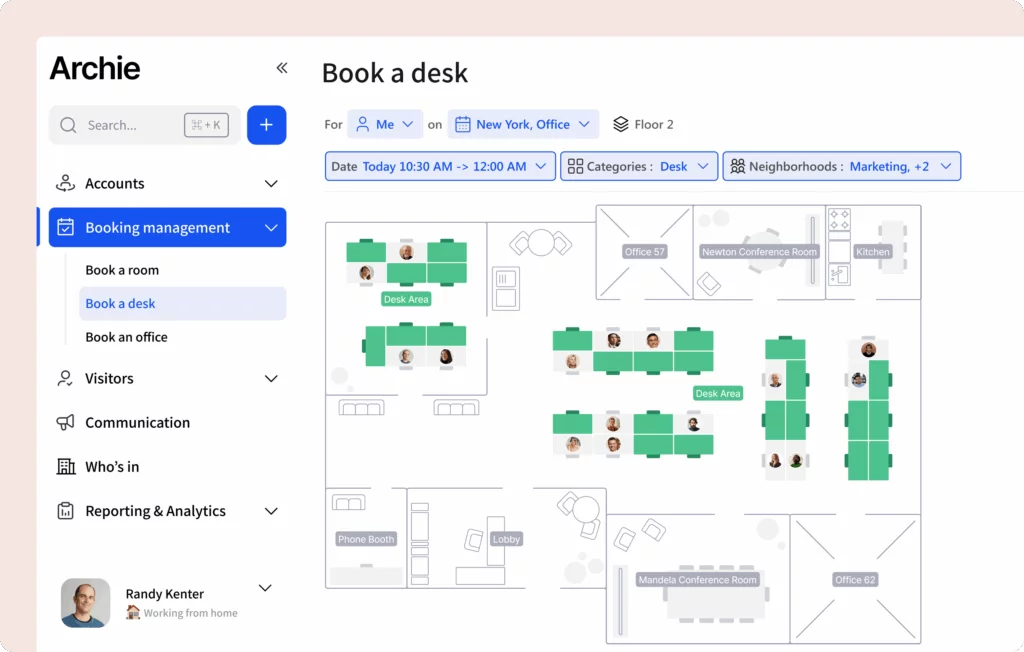
🔑 Key features
- Book desks & meeting rooms: Employees can reserve workspaces in advance or set up recurring bookings. Those who need a fixed desk can also get assigned one.
- Check out interactive floor plans: Employees can check a digital office map to find and book available desks or meeting rooms easily.
- Find coworkers: Archie helps employees locate where their coworkers are sitting and track who’s in the office that day.
- Create team zones: You can set up dedicated areas for teams to work together while still offering flexible seating options.
- Check-in office guests: Visitors can be preregistered and checked in using a QR code, which makes the process fast and secure while keeping a digital visitor log.
- Access the booking features via mobile phones: Using the Archie mobile app, employees can manage desk and room reservations directly from their phones.
- Track office space usage: Detailed reports show which desks and meeting rooms are used the most, helping you make the best use of your office space.
💰 Pricing
Archie starts at $159/month — including 25 desks or meeting rooms, mobile access, and high-quality support. Visitor management and other features can be added for an additional cost. You can test it for free for 14 days.
🔍 Pros & cons
➕ Easy to use: The simple interface makes it quick for employees to get used to.
➕ Affordable for growing teams: The pricing model is cost-effective, especially for companies with flexible office attendance and growing teams.
➕ Helpful customer support: Reviews from G2 and Capterra highlight great support from the Archie team.
➖ Not Ideal for small offices: The basic plan includes 25 resources, which might be more than smaller offices need.

#2 OfficeSpace
🏆 Rating: 8.5/10
OfficeSpace is a powerful office space management tool that is great for companies looking for a high-end solution. However, its pricing is on the higher side, making it a better fit for businesses with bigger budgets.
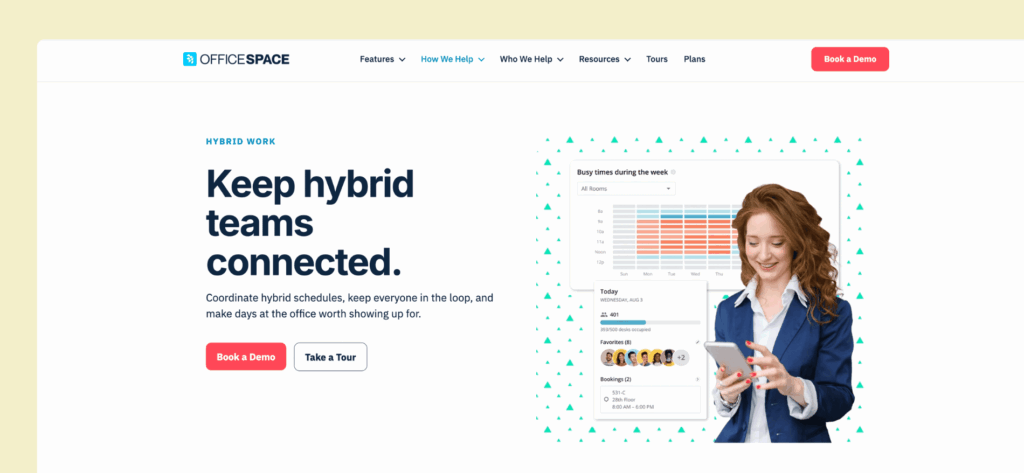
🔑 Key features
- Book meeting rooms: Your employees can schedule meeting rooms in advance or on the spot.
- Assign desks with flexibility: You can give employees permanent desks or allow them to book shared desks as needed.
- Manage visitors easily: A check-in system helps track office visitors and improves workplace security.
- Keep track of office deliveries: Employees get notified when packages arrive, and deliveries are recorded to prevent lost parcels.
- Get data on office usage: OfficeSpace provides detailed reports on how desks, meeting rooms, and other office spaces are being used, helping businesses optimize layouts.
💰 Pricing
Product research shows that OfficeSpace starts at around $60 per user per month, and there’s an additional setup fee. The pricing is not available on the website though, so it’s best to contact OfficeSpace directly for a custom price.
🔍 Pros & cons
➕ Advanced features: OfficeSpace offers a full range of tools for managing offices, including advanced reporting and space planning.
➕ Great for large offices: Ideal for companies needing detailed space management on a bigger budget.
➖ Can get pricey: The per-user pricing model adds up quickly, especially for larger teams. Plus, the $2,500 setup fee can be a big upfront investment for some companies.
#3 Robin
🏆 Rating: 8.3/10
Robin is an easy-to-use office management tool that helps hybrid teams book desks and meeting rooms without hassle. It gives real-time updates on which spaces are available and works well with other workplace tools. This makes it simple for employees to plan their office days, find the best workspaces, and collaborate with their teams.
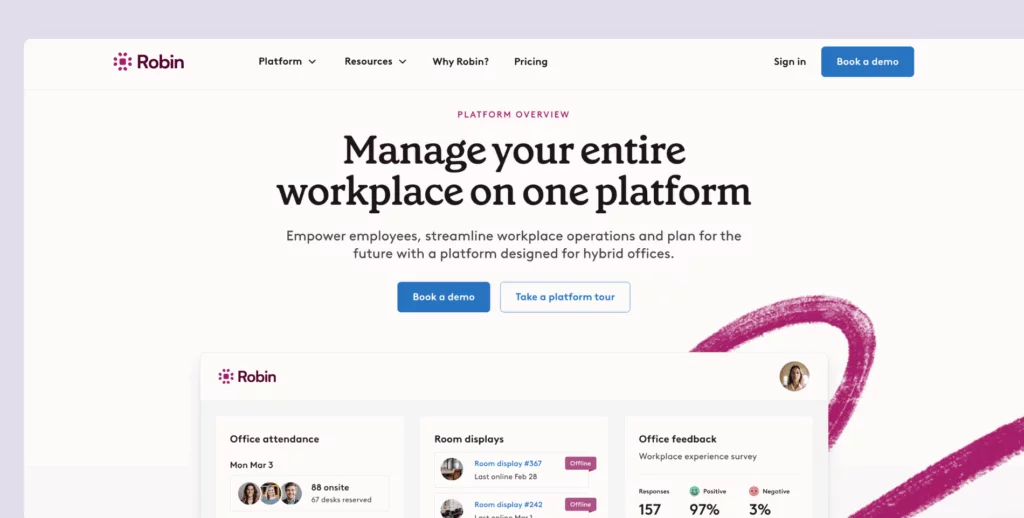
🔑 Key features
- Book meeting rooms: Employees can book a meeting room with just one click or check in when they arrive.
- Reserve desks: Robin suggests the best desk based on an employee’s past bookings and preferences.
- See live office maps: Employees can see a real-time office map to find open desks and meeting rooms easily.
- Manage employee check-ins: Robin supports QR codes, WiFi-based auto check-ins, and access control systems integration.
- Analyze office space usage: It tracks office occupancy, busiest times, and space efficiency to help you optimize your space usage.
💰 Pricing
Product research shows that plans start at around $70 per user per month, but pricing is not disclosed on Robin’s website, so it’s best to contact them directly for a custom quote. There’s a free trial available to test out its features.
🔍 Pros & cons
➕ Perfect for desk & meeting room booking: Robin makes it really simple to reserve workspaces and even provides suggestions on which desks to book.
➕ Live updates on office usage: Employees always know which spaces are free and where their colleagues are.
➖ Can get expensive for bigger teams: Robin charges per user, so costs can add up quickly. However, the pricing details are not publicly displayed.
#4 Envoy
🏆 Rating: 8.2/10
Envoy helps companies organize their hybrid workplaces while keeping security a priority. Employees can easily book desks and meeting rooms, visitors can check in smoothly, and deliveries are tracked — all in one system.
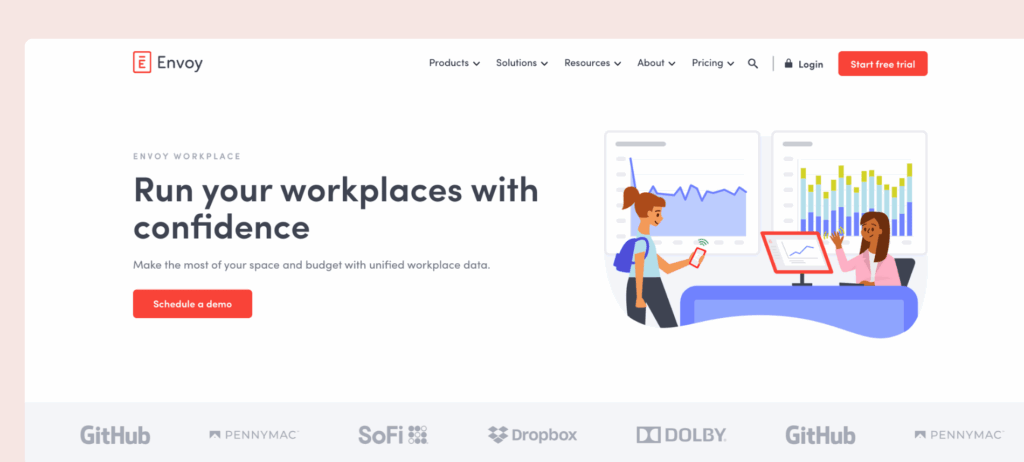
🔑 Key features
- Book desks & meeting rooms: Employees can quickly reserve a workspace before coming in, or whenever they need one.
- Keep the office safe: Features like visitor check-ins, capacity limits, and emergency alerts help you improve office security.
- Track deliveries: Employees get notified when their packages arrive, so no parcel gets lost.
- See how your office is used: Detailed reports show which areas are busy and which are underused.
- Integrate with other tools: Envoy Works smoothly with popular workplace tools like Microsoft 365 or Slack.
💰 Pricing
Pricing starts at $5 per active user per month (billed annually) for room & desk booking. Visitor management is sold separately.
🔍 Pros & cons
➕ Focus on office security: Advanced features like visitor check-ins and capacity tracking help you keep the workplace safe.
➕ Useful analytics: Envoy provides quite detailed workplace reports and insights.
➖ Can get expensive – Since Envoy charges per user, costs can add up for big teams.
#5 Skedda
🏆 Rating: 8/10
Skedda is a simple space management system that helps teams manage desks, meeting rooms, and office spaces. Whether you run a hybrid office, coworking space, or event venue, Skedda makes it simple to reserve spaces, set booking rules, and keep your place organized.
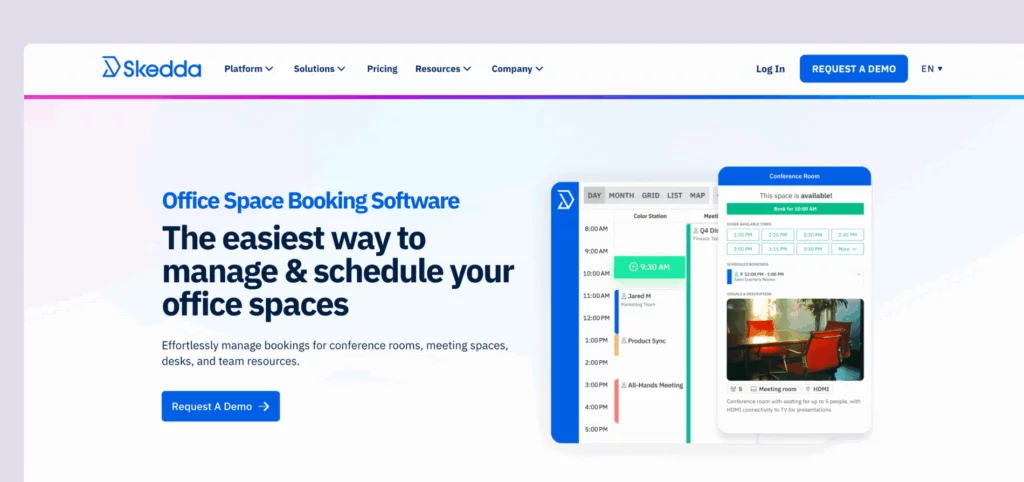
🔑 Key features
- Book desks and rooms: Employees can quickly reserve a desk or meeting room with a simple drag-and-drop system.
- Access interactive office maps: A visual layout helps employees see which spaces are available and where they want to work.
- Set custom booking rules – Set time limits, cancellation policies, and other rules to organize office space.
- Create team zones: Assign specific areas for teams so they can collaborate while still having flexible seating.
- Connect with other tools: Skedda integrates with other tools like Slack, Kisi, and Google Workspace to make office management even smoother.
💰 Pricing
Skedda starts at $99/month for up to 15 spaces. Higher plans and a free trial are available.
🔍 Pros & cons
➕ Ease of use: The simple interface makes it easy for teams to start using right away.
➕ Customization: You can set up multiple booking rules to fit your office needs.
➖ Basic reporting: Skedda doesn’t offer as many insights on office usage as some other space management tools.
#6 Kadence
🏆 Rating: 7.8/10
Kadence makes office space management simple while keeping costs under control. It’s known for being user-friendly and having great customer support, which makes it a reliable choice — especially for companies with a hybrid work setup.
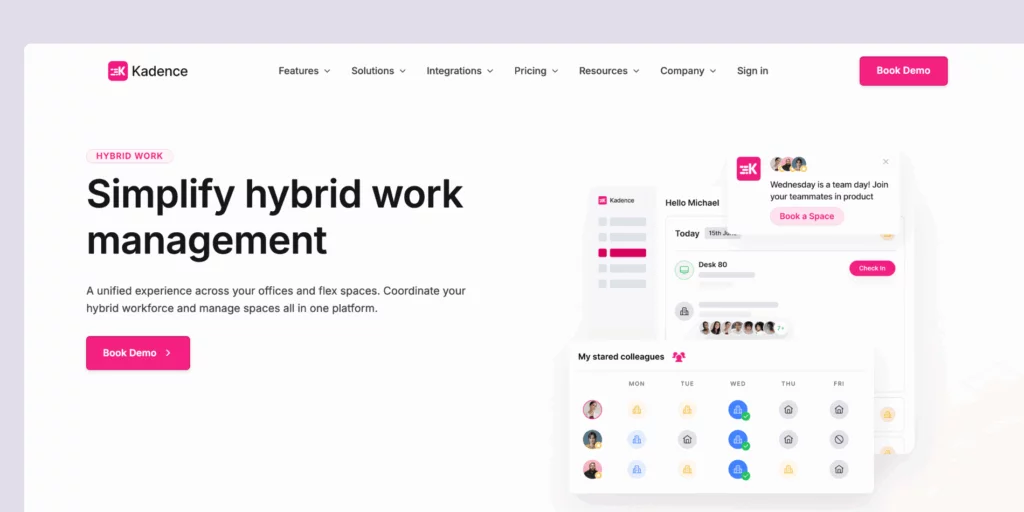
🔑 Key features
- Book desks & conference rooms: Employees can quickly reserve desks and conference rooms whenever they need them.
- Check out interactive office maps: Employees can see which desks and meeting rooms are available and where they’re located.
- Get smart booking suggestions: Kadence helps everyone find the best desk based on past bookings and team preferences.
- Set real-time alerts: Employees get notified when a teammate cancels a booking or when their preferred desk becomes available.
- Download a mobile app: Employees can book and manage their reservations from their phones.
💰 Pricing
Kadence starts at $4 per active user per month. Custom pricing is available for bigger teams.
🔍 Pros & cons
➕ Easy to use: The simple layout makes it quick for employees to find and book workspaces.
➕ Great customer support: Users praise how responsive and helpful the support team is.
➖ Per-user pricing: Costs can add up for large teams compared to the resource-based pricing models.
#7 Tactic
🏆 Rating: 7.6/10
Tactic is a great choice for companies looking for an easy way to manage office spaces. Its simple booking system and multiple integrations make it easy for employees to reserve desks and meeting rooms. While it doesn’t offer advanced reporting, it’s still a solid, budget-friendly option.
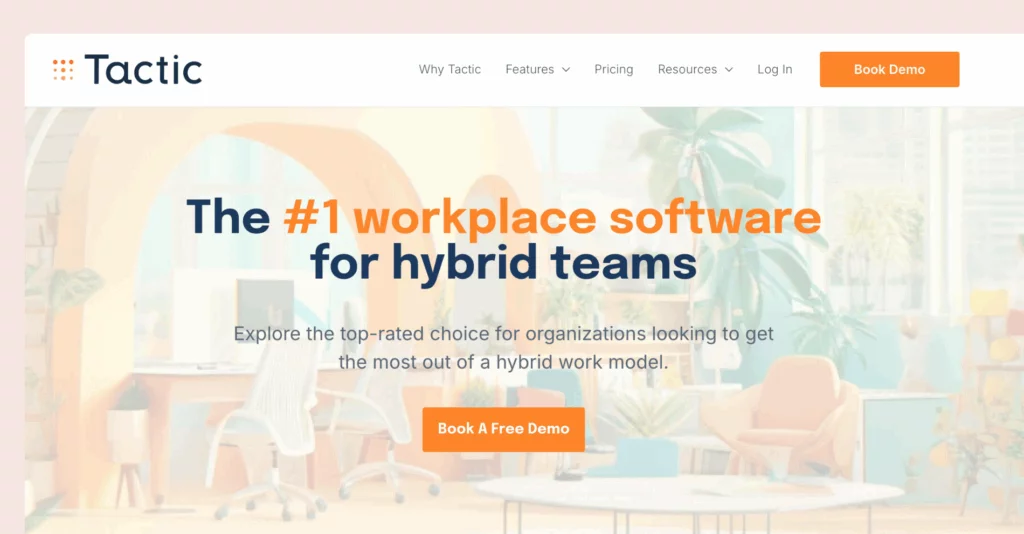
🔑 Key features
- Book meeting rooms: Reserve rooms in advance to avoid double bookings.
- Reserve desks: Employees can easily book desks for the days they’ll be in the office.
- Create dedicated zones: Organize desks by teams or departments to keep coworkers together.
- Assign seats: Choose permanent desks or rotate seating based on need.
- Set booking limits: Control how far in advance desks can be reserved to keep it fair for everyone.
💰 Pricing
Tactic starts at $3 per desk per month and $6 per meeting room per month. Visitor management is sold separately and costs $99 per location. A free trial is available to test it out.
🔍 Pros & cons
➕ Easy to use: The interface is simple, making it quick for employees to book spaces.
➕ Flexible booking options: Tactic is a solid choice for teams with changing schedules.
➖ Occasional technical issues: Some users report minor technical issues, especially when logging in for the first time.
#8 Officely
🏆 Rating: 7.5/10
Officely is an easy-to-use tool that helps teams book desks and meeting rooms directly from Slack or Microsoft Teams. Since it works inside the communication tools your team already uses, there’s no need to switch between apps or learn a new system.
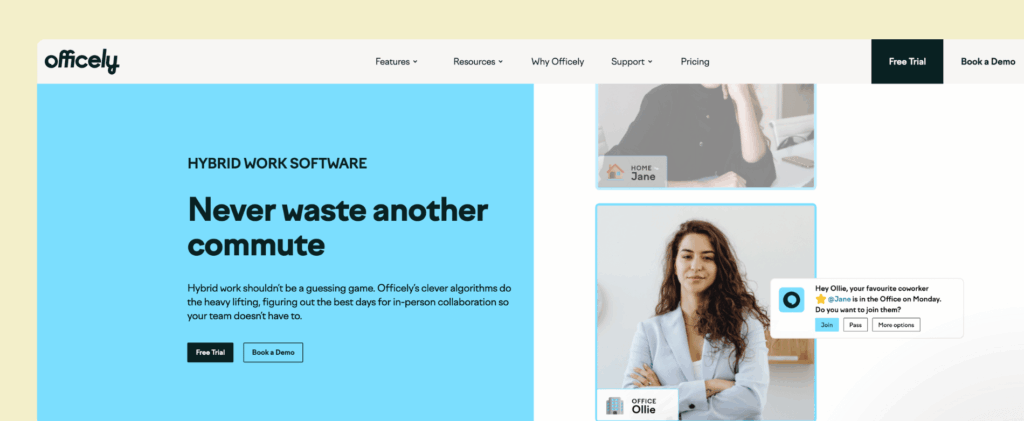
🔑 Key features
- Book desks inside Slack & Teams: Employees can reserve desks and meeting rooms without opening another app.
- See who’s in the office: Check which coworkers will be in and plan meetings or collaboration.
- Plan office events: Organize team lunches, meetings, or social gatherings with built-in scheduling.
- Track office usage: Get basic reports on office attendance and space usage.
💰 Pricing
Pricing starts at $2.50 per user per month. Officely is free for teams with up to 10 users, and there’s a free trial available.
🔍 Pros & cons
➕ Great for hybrid teams that rely on communication apps: Officely helps employees plan office days and book workspaces inside Slack or Microsoft Teams.
➕ Budget-friendly: Free for small teams and affordable for growing businesses.
➖ Works only with Slack & Teams: If your company doesn’t use these platforms, Officely won’t be useful.
More office space management software options
#9 Eden – All-in-one platform for desk booking, visitor check-ins, office maintenance, and safety compliance.
#10 YAROOMS – Full-featured workspace management software for managing desks, meeting rooms, and visitor check-ins.
#11 Eptura – Comprehensive system for workspace reservations, analytics, and office planning.
#12 OfficeRnD – Designed for coworking spaces, with desk booking and membership management features.
#13 GoBright – Complete office management tool with desk booking, meeting rooms, and visitor tracking.
#14 Spacewell – Optimizes office layouts with desk and meeting room booking features.
#15 Spaceti – Uses smart technology for workspace reservations and occupancy tracking.
#16 HybridHero – Combines HR and office management with desk and room booking tools.
#17 Deskbird – Simple and mobile-friendly tool for reserving desks and meeting rooms.
#18 Clearooms – Easy-to-use desk and conference room booking system for flexible workspaces.
#19 MyDesk – Straightforward solution for managing desk reservations and hybrid work schedules.
#20 Meetio – Desk and meeting room booking tool that integrates with office calendars.
#21 Zynq – Helps teams reserve desks and meeting rooms efficiently.
#22 Nibol – Allows teams to book desks and rooms while tracking office space usage.
#23 Flydesk – Simple tool for managing desk reservations and office resources.
#24 Ronspot – Designed specifically for hybrid offices to manage desk bookings.
#25 Cloudbooking – Flexible platform for reserving office desks and meeting rooms.
#26 Poppulo – Mobile-friendly app for booking desks and meeting rooms.
#27 Tidaro – Workspace management software for booking desks and rooms in hybrid offices.
#28 Smartway2 – Intelligent scheduling software for booking desks and rooms with powerful analytics.
#29 UnSpot – Workspace management software with built-in office usage analytics.
#30 AgilQuest – Office space management software with built-in analytics to track usage.
#31 FMS:Workplace – Combines software and hardware for seamless scheduling and office optimization.
#32 WorkInSync – Manages desk and room bookings with a focus on hybrid workplaces.
#33 Othership – Helps teams reserve office resources for better space management and collaboration.
#35 Joan – Helps businesses manage desks, meeting rooms, visitors, and office equipment.
How to choose office space management software
Here’s a simple guide to help you choose the best office space management software:
1. Think about your needs
Office space management tools have a lot of built-in capabilities or add-ons if needed. To figure out what’s the best choice for your office, ask yourself (and your team, too!):
- Do you need to manage desks, meeting rooms, or both? Think about what spaces in your office need organizing. Some tools focus on just rooms or desks, while others handle everything.
- Is visitor management important? If your office gets frequent guests — clients, job candidates, or partners — a visitor check-in system can make entry smooth and secure. Some platforms include visitor management, while others offer it as an add-on.
- Do you want to track how your office space is used? Workplace analytics can show you which desks or rooms are popular, which are underused, and whether you have enough space for your team.
- What integrations are you going to take advantage of? If your team relies on Slack, Microsoft Teams, or Google Calendar, look for a system that integrates smoothly so bookings and schedules stay organized in one place.
2. Consider ease of use
Make sure to check how intuitive the web and mobile apps are. Both employees booking desks and managers tracking space usage should find the space management software easy to use. If a system is too complicated, people might avoid using it, so investing in one makes no sense.
3. Check pricing & scalability
Pricing can vary based on how office space management software charges — some tools charge per user, which can become expensive as your team grows. Others charge per resource, like desks or meeting rooms, making it more cost-effective for companies with more employees than office space. Watch out for hidden costs, like setup fees or extra charges for analytics or visitor check-ins. The space management software should be able to scale with your business as it grows.
4. Read customer reviews
Before choosing office space software, take a moment to see what real users say about it on websites like G2 or Capterra. Even if a platform seems to have great features, it might as well have bugs, a confusing interface, or slow customer support.
5. Test before you commit
Most office space management tools offer free trials or demos. It’s a good opportunity to check if the software fits your office needs and get feedback from employees who will use the system every day before you commit to a specific office management software.
Once you’re at it, you might want to give Archie a try. It helps manage your office space by giving you all the tools to organize, book, and track how your workspaces are being used. Teams can easily reserve desks and meeting rooms through web, mobile, or apps like Slack and Outlook, while admins get live floor plans, usage data, and flexible settings to assign or restrict access.
With built-in check-ins, smart reminders, and detailed analytics, Archie makes it simple to reduce unused space, support flexible work, and keep your office running smoothly.
Article sources:
- Review sites (G2, Capterra)
- Archie’s product research
- Competitor website analysis

Berenika Teter
Archie's Content Manager, fueled by filter coffee and a love for remote work. When she’s not writing about coworking spaces and hybrid workplaces, you can probably find her exploring one.























